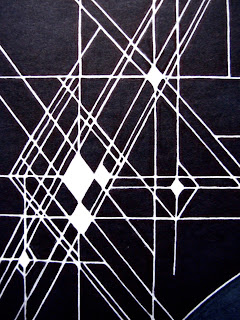 Well, first I suppose there's the obvious: starlight...though the amount and quality would vary significantly depending on local conditions. Temperature, humidity, and air pollution certainly play a role, as does light pollution. Whether or not you're in or near a big city, underneath a streetlight, or perhaps temporarily blinded by an unwitting cell phone user, can all mean the difference between sailing away on the Milky Way's starry billows, or straining just to make out the constellations.
Well, first I suppose there's the obvious: starlight...though the amount and quality would vary significantly depending on local conditions. Temperature, humidity, and air pollution certainly play a role, as does light pollution. Whether or not you're in or near a big city, underneath a streetlight, or perhaps temporarily blinded by an unwitting cell phone user, can all mean the difference between sailing away on the Milky Way's starry billows, or straining just to make out the constellations.Starlight is emitted light: light born of atomic reactions deep within the cores of distant giants. It shines forth across unimaginable distances, and can afford us a tantalizing glimpse into the past. Some of the photons of starlight we see today originated when the dinosaurs walked the Earth, when the first humans ventured out from prehistory, when Mozart wrote his first symphonies, and on the day you were born. The light from our nearest star, the sun, only left its surface about eight minutes ago, but its reflected rays afford us some fascinating local subjects of observation.
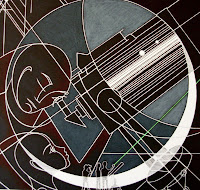 The second brightest object in our night sky, the moon, shines only through reflected sunlight, but can still be brilliant enough to interfere with our views of fainter astronomical objects like galaxies, nebulae,
The second brightest object in our night sky, the moon, shines only through reflected sunlight, but can still be brilliant enough to interfere with our views of fainter astronomical objects like galaxies, nebulae,and even stars. The best time to explore the night sky is when the moon is just a thin crescent...or at least a quarter or less illuminated. This is also the best time to view some of the moon's most interesting features, as shadows along the terminator cast lunar mountains, craters, and valleys into sharp relief. Even as a crescent, the fullness of the moon may still be visible. Our planet, with its swirling clouds, snowy mountain ranges, and ice caps, reflects enough sunlight to brighten our nearest neighbor with a pale glow called Earthshine. The translucent gleam of this secondary reflection can lend a magical feel to late evening or early morning observations.
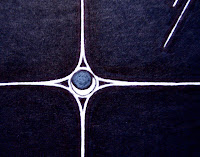 Planets within our solar system are also made visible to us through reflected sunlight. Because it orbits closer to the sun than we do, Venus can be seen to go through phases just like our moon does. Its disc waxes near full when on the far side of the sun, and then wanes into a thin, but larger crescent as it ventures back onto our side. Because of its proximity, and the fact that its surface is completely covered by a thick layer of highly reflective clouds, Venus shines brightly in crepuscular skies: its apparent magnitude rivaled only by the moon, the international space station, and the occasional iridium flare.
Planets within our solar system are also made visible to us through reflected sunlight. Because it orbits closer to the sun than we do, Venus can be seen to go through phases just like our moon does. Its disc waxes near full when on the far side of the sun, and then wanes into a thin, but larger crescent as it ventures back onto our side. Because of its proximity, and the fact that its surface is completely covered by a thick layer of highly reflective clouds, Venus shines brightly in crepuscular skies: its apparent magnitude rivaled only by the moon, the international space station, and the occasional iridium flare.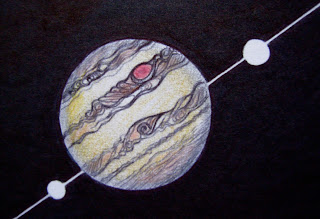 Less bright (but no less showy), Jupiter and its cadre of moons dance across the sky like a circus in slow motion. Though distant, this immense planet is always fully illuminated by sunlight, and every night displays a different configuration of surface detail and moons. Had it been just a bit more massive, Jupiter may actually have become a star...and our view of the sky at this star party would be much different!
Less bright (but no less showy), Jupiter and its cadre of moons dance across the sky like a circus in slow motion. Though distant, this immense planet is always fully illuminated by sunlight, and every night displays a different configuration of surface detail and moons. Had it been just a bit more massive, Jupiter may actually have become a star...and our view of the sky at this star party would be much different!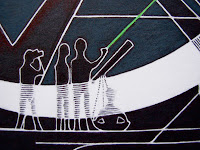 To help direct viewers across the map of the sky, star party enthusiasts often point things out using a highly focused variety of emitted light: a green laser. The beams seem to reach to infinity as they scatter through the atmosphere and show the way to distant celestial wonders. And no star party would seem complete without the muted cast of dim red lights. Such lights help illuminate maps, equipment, and step ladders without interfering with the eye's ability to dark adapt. When fully dark adapted, a process that takes about half an hour, the dome of the sky deepens invitingly, and faint details can emerge from an otherwise featureless gray smudge centered in a telescope's eyepiece.
To help direct viewers across the map of the sky, star party enthusiasts often point things out using a highly focused variety of emitted light: a green laser. The beams seem to reach to infinity as they scatter through the atmosphere and show the way to distant celestial wonders. And no star party would seem complete without the muted cast of dim red lights. Such lights help illuminate maps, equipment, and step ladders without interfering with the eye's ability to dark adapt. When fully dark adapted, a process that takes about half an hour, the dome of the sky deepens invitingly, and faint details can emerge from an otherwise featureless gray smudge centered in a telescope's eyepiece.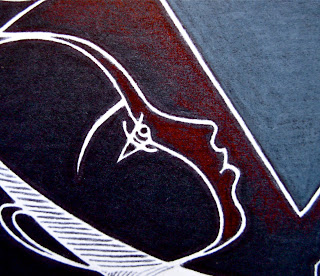 After all is said and done, most would agree that the best kind of light readily observable at every star party, is that which comes into the eyes of a new observer when they first see the rings of Saturn, the shimmer of a globular star cluster, or mountains on the moon. This light is also sustained in the eyes of a more seasoned participant by viewing and studying the same. That light was ignited in me after I spontaneously pulled into the parking lot of a Harmon's grocery store in Sandy, Utah, curious about the forest of telescopes that had sprung up out of nowhere...and the rest, as they say, is history.
After all is said and done, most would agree that the best kind of light readily observable at every star party, is that which comes into the eyes of a new observer when they first see the rings of Saturn, the shimmer of a globular star cluster, or mountains on the moon. This light is also sustained in the eyes of a more seasoned participant by viewing and studying the same. That light was ignited in me after I spontaneously pulled into the parking lot of a Harmon's grocery store in Sandy, Utah, curious about the forest of telescopes that had sprung up out of nowhere...and the rest, as they say, is history.So...
Three cheers for star parties everywhere!
And by the way, the illustrations for this post were all taken from my most recently finished "Astronomical Abstract" of the same name...
"Varieties of Light"
Sharpie, Bic pen, and colored pencil, on white paper
dimensions: 16.25 x 10.75 inches


This is one of the best you've ever posted. Thanks for the great tour through light and space. The artwork makes me want to take a child to a star party and watch the "lights" go on in their eyes. You've really expressed so much love here. WOW and WOW!!!
ReplyDeleteThanks Mom!
ReplyDelete